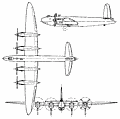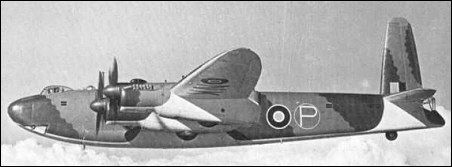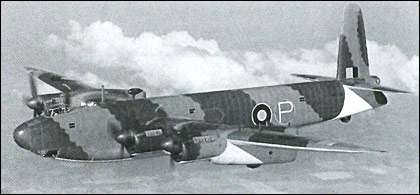|
| The Barnes Wallis geodetic construction, introduced on the Vickers Wellesley and used later on the Vickers Wellington and Vickers Warwick, was highly successful. To exploit its physical characteristics fully, however, a very big aeroplane was desirable.
Vickers' designer, Rex Pierson, used geodetics in evolving a four-engined bomber to meet Specification B.13/36, but the Short Stirling was awarded the contract. Another opportunity came with Specification B.1/39, but this was again unsuccessful, and it was not until the submission to Specification B.5/41 that the Vickers tender was accepted.
The requirement was for a high-altitude heavy bomber with pressurized crew compartment, and an ability to fly at 555km/h at 9450m. Two prototypes of the new bomber were ordered, but changes resulted in a new specification, B.3/42, being drawn up. Vickers designated their design the Type 447, and the name Windsor was given to the aircraft. Various armament trials were carried out on a Warwick prototype, and the first Windsor flew from Farnborough, where it had been assembled, on 23 October 1943. It attained a speed of 486km/h at 7620m, and had completed almost 34 hours of flight testing before being written off in a forced landing, caused by problems with a propeller constant-speed unit. The second prototype, Type 457, contained armour plating and other modifications, and flew from Wisley on 15 February 1944, demonstrating similar performance to the first aircraft. This aircraft was grounded in June 1946, and broken up.
A third Windsor, Type 480, was flown on 11 July 1944, with some further changes incorporated. This aircraft was fitted later with defensive barbettes in the outboard engine nacelles, each barbette having two remotely-controlled rear-firing 20mm cannon.
Trials for these were carried out by a Lancaster, but although further tests continued for some 10 months, the Windsor programme was cancelled on 15 March 1946, with the third aircraft finishing its days as an instructional airframe. A fourth Windsor, originally Type 471 but later changed to Type 483, was almost complete when the programme finished.
 | A three-view drawing (800 x 796) |
| WEIGHTS |
| Take-off weight | 24500 kg | 54014 lb |
| Empty weight | 17500 kg | 38581 lb |
| DIMENSIONS |
| Wingspan | 35.71 m | 117 ft 2 in |
| Length | 23.42 m | 77 ft 10 in |
| Height | 7.01 m | 23 ft 0 in |
| Wing area | 115.94 m2 | 1247.97 sq ft |
| PERFORMANCE |
| Max. speed | 510 km/h | 317 mph |
| Ceiling | 8305 m | 27250 ft |
| Range | 4650 km | 2889 miles |
| ARMAMENT | 2 x 7.7mm machine-guns, 2 x 20mm cannon, 5500kg of bombs |
| petdav, e-mail, 18.08.2014 12:21 I have just read a book by Eric "Winkle" Brown, who test flew the Windsor and he states that the wingtips flapped up and down at least six foot, and the whole thing reminded him of a seagull in flight. reply | | ERNEST BARTON, e-mail, 02.05.2013 16:21 The guns are no more complex than the ones on the B36. These bombers were intended to fly higher than most German fighters could reach and drop Earthquake bombs. I think at least one should have been kept - it was full of ideas before their time and a beautiful Whale like shape that makes the Lincoln look like a cardboard Box. reply | | John, e-mail, 05.04.2013 21:06 I just completed a 1 /72 scale scratch built model
and seeing it in hand it is quite cool. reply | | coleighf, e-mail, 26.09.2012 17:58 I'm a bit late coming into this one, but as far as the nacelle barbettes were concerned there were no gunners in them. They were remotely controlled by a gunner in the tail with good all round view and had an excellent field of fire. The results of extensive tests with them fitted to a Warwick were very successful, the technology then was perfectly capable of managing this. Some of the bomb aiming and gun sighting systems were very sophisticated by the end of the war. This one was just taken over by events. reply | |
| | Scottb60, e-mail, 05.06.2012 04:43 They could all be aimed at the same spot, or within a few feet of the other guns. Sounds pretty reasonable to me. If they were all aimed remotely to the gunners aim it would be pretty simple. All you have to do is synchronize the position of the three guns to the desired location. I would have thought they had small electric motors then. reply | | This guy, e-mail, 05.06.2012 00:00 I think the windsor is pretty cool. Probably my most favorite british bomber. reply | | Mordred, e-mail, 29.05.2012 09:58 There is an old saying "If it looks right, it is right" and this aircraft looks absolutely dreadful. Wheels under each of the four engines? Remotely controlled armament at the rear of each of the engines controlled by the gunner located in the tail of the aircraft? Oh, for heavens sake ! Thankfully post WW2 we were at the dawn of the jet age and this aircraft was obsolete before it could become operational. reply | | ERNEST BARTON, e-mail, 01.08.2011 04:52 The type was to have been covered in fabric incorporating stainless steel ribbons and fibreglass precursors of modern composite structures it is a pity at least one was not kept as far from being ugly It strikes me as one of the most elegent four engine bombers ever designed and a six engine version would have been even better. reply | | loulou, 20.06.2011 12:17 calculate the difference in parallax at various target distances, and accomplish that both instantly and continuously. I find it difficult to believe that such technology existed in the 1940s! reply | | Klaatu, e-mail, 10.06.2011 22:20 The defensive armament scheme sounds like a potential nightmare. The guns were to be mounted in the outboard engine nacelles, and presumably aimed by a gunner in the compartment in the tail. That means that the gunner's point of view for aiming the guns would be so far from the actual position of the guns that a computer would be required to calculate the difference in parallax at various target distances, and accomplish that both instantly and continuously. I find it difficult to believe that such technology existed in the 1940s! reply | | bombardier, e-mail, 25.05.2011 10:03 The ugliest British heavy bomber reply | | justo miranda, e-mail, 17.12.2007 22:48 www.secretprojects.co.uk /forum /index.php /topic,3060.30.html
please see this url reply | | Daniel, 21.02.2007 22:26 Je recherche d�sesp�rement un plan 4 vues digne de ce nom afin de r�aliser une maquette au 1 /72. reply |
|
Do you have any comments?
|
| 
COMPANY
PROFILE
All the World's Rotorcraft
|








